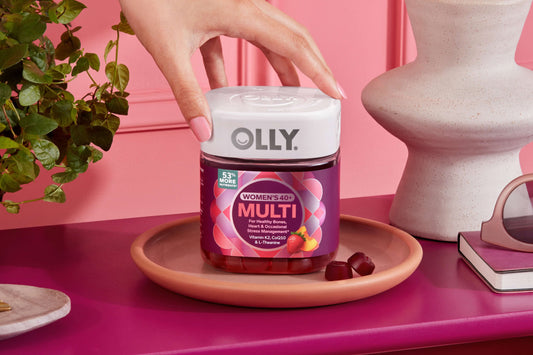Between packing lunches, keeping track of after-school activities, and mentally cycling through "Did they get enough protein? Vegetables? Healthy fats? Oh, and fiber—wasn't that important too?"—feeding your kiddo well can feel like nutritional Tetris. And you're definitely not alone.
The Goods Inside
- What is fiber, exactly?
- 5 reasons why it’s so important for kiddos to get enough fiber
- A delightful way for kids to get more fiber on the daily
Turns out, that nagging feeling about fiber might be onto something:
9 out of 10 children don’t get the daily recommended amount of fiber.1
Here's the reality: most kids only get about half the fiber they need each day. This can lead to some occasional digestive discomfort.
If this has been on your mind, you’re in good company. Kids’ digestive health is a top concern for parents, and they're increasingly looking for proactive ways to support it.2
The good news? Supporting your child's fiber intake doesn't have to involve Brussels sprouts battles or complicated meal prepping (unless that’s your thing!).
Sometimes the simplest solutions are the most effective—and kid-approved. So, what is fiber, why do kids need it, and why is it so hard to get enough? Let’s talk about it.


What is Fiber, Exactly?
When you eat carbs like bread, pasta and rice, they get broken down and digested in the mouth, stomach and intestines.
Fiber is a different type of carb. Because your body doesn't digest it, fiber makes it to the large intestine (AKA your bowels) intact.
Your large intestine is home to trillions of lil’ bugs—also known as your gut microbes—who get really excited to see fiber.
Your gut microbes feed on this fiber, which gives them fuel and energy to thrive and multiply. And that’s exactly why it’s so beneficial to the body!
Meanwhile, fiber also absorbs water, helping to soften stool and add bulk to keep things moving along smoothly through the digestive system.
So, this nutrient is pretty important. Let’s talk about why getting enough matters so much for your kids’ health.
5 Ways Fiber Helps Your Kiddos Feel Their Best
#1: Supports Their Digestion*
Fiber gives stool the bulk and softness it needs to pass through the body smoothly, without being too hard or too soft.3 And let’s be real, no parent wants to deal with the aftermath of either extreme.
#2: Helps Keep Them Regular*
Pooping on a regular basis is important for kiddos so they don’t get too backed up. Fiber helps to keep bowel movements on a more regular schedule, so that their systems (and your house!) can run a little smoother.4
#3: Increases Those Good Bacteria*
Good gut bacteria feed on fiber, helping them to grow big and strong. Studies show that taking a fiber supplement helps increase levels of good gut bacteria.5 It's like giving gut bacteria the snack they actually want.
#4: Supports a Healthy Gut Microbiome*
When good gut bacteria grow, they eventually crowd out bad gut bacteria. In fact, a study found that when kids added a fiber supplement to their daily routine, they had a better balance of good to bad bacteria levels, key to a healthier gut microbiome.6 Their gut is basically building its own friend group of good guys.
#5: Helps Keep Their Bowels Working Normally*
Through each of these benefits, fiber helps keep kids’ bowels working normally: supporting a healthy gut microbiome, digestion and regularity.6 And when things are working as they should, you can focus on the fun stuff, without the worry of tummy troubles.
How Much Fiber Do Kiddos Need?
So, how much fiber do kids actually need? Hint: It’s higher than you may think. According to the Dietary Guidelines for Americans, the amount of fiber kids need increases as they get older, and is higher for boys.
Let’s break it down in terms of the number of medium apples kids would need to eat per day to get enough fiber.7


To put that in perspective, a teenage boy needs about 6 medium apples worth of fiber every day. We know. That sounds like a sh*t ton.
How Can Kids Get Fiber in Their Diet?
Fiber is found in plant foods like fruits, vegetables, whole grains, nuts and seeds. The good news? There are plenty of kid-friendly options that can help them up their daily intake.
Here are some fiber-rich foods that just may stand a chance with picky eaters:


Even with all these options, getting kids to consistently eat enough high-fiber foods can feel like an uphill battle. Between busy schedules, picky eating phases, and the fact that many kid favorites (looking at you, chicken nuggets!) don’t have much fiber, it's no wonder that only 1 in 10 kids meet their daily needs.
That's where a little extra support can make all the difference.
Here’s Help: Kids Friendly Fiber
Adding a fiber supplement to your kiddos’ daily routine helps get them closer to their daily needs. But here’s the thing about most fiber supplements—they're not exactly picky-eater friendly.
Enter: OLLY Kids Friendly Fiber.
“Most kids (and their parents!) aren't getting enough fiber on the daily. So, we created a fiber supplement that parents can feel good about giving their kids, and that kids are excited to take.”
Dorothy Huynh, Gut Health Brand Manager
Kids Friendly Fiber is designed with your kiddos in mind. These berry flavored gummy supplements are formulated for kids ages 2+ to help them get the fiber they need each day to support regularity and digestive health.*
These gummies have 3 g of plant-based prebiotic fiber per 2 gummies from Fructooligosaccharides (FOS).
Let’s break that down: It’s a carbohydrate (fructo) consisting of a few (oligo) sugar units (saccharide).
This serving, 3 grams of FOS, has been studied to support kids’ healthy digestion and to help keep them regular.*3,4


A Delightful Addition to Your Kiddos Daily Routine
Kids Friendly Fiber gummies are designed for delight. They have a tart and juicy blend of blueberry and raspberry flavors with other natural flavors—a part of your kiddos’ daily wellness routine they'll want to come back to. They’re also gluten free and made with no synthetic colors.
Your kiddos deserve to feel their best, more comfortable selves every day, and that includes their digestive health.
Kids Friendly Fiber makes gut health support simple and enjoyable—no bribes, no battles, just a tasty daily gummy that gets to work supporting healthy digestion.*
If you need support when teaching your kids about how to find more fiber, introduce them to Frank, he’s really friendly!
Because when your little one feels good, they can do all the things that make them, them: learning, playing, and being wonderfully, unapologetically themselves.
References
1. Moshfegh, A., Goldman, J., & Cleveland, L. (2005, September). What We Eat in America, NHANES 2001 2002: Usual Nutrient Intakes from Food Compared to Dietary Reference Intakes. USDA. https://www.ars.usda.gov/ARSUserFiles/80400530/pdf/0102/usualintaketables2001-02.pdf - New Window
2. US children and Health Consumer Report 2024. Mintel. (2025, January 21). https://store.mintel.com/report/us-children-and-health-market-report - New Window
3. Nakamura, S., Sarker, S. A., Wahed, M. A., Wagatsuma, Y., Oku, T., & Moji, K. (2006). Prebiotic effect of daily fructooligosaccharide intake on weight gain and reduction of acute diarrhea among children in a Bangladesh urban slum: A randomized double-masked placebo-controlled study. Tropical Medicine and Health, 34(3), 125–131. https://doi.org/10.2149/tmh.34.125 - New Window
4. Moore, N., Chao, C., Yang, L.-P., Storm, H., Oliva-Hemker, M., & Saavedra, J. M. (2003). Effects of fructo-oligosaccharide-supplemented infant cereal: A double-blind, randomized trial. British Journal of Nutrition, 90(3), 581–587. https://doi.org/10.1079/bjn2003950 - New Window
5. Tokunaga, T., Nakada, Y. (1993). Effects of Fructooligosaccharides Intake on the Intestinal Microflora and Defecation in Healthy Volunteers. J-STAGE, 6(2), 143–150. https://www.jstage.jst.go.jp/article/jim1987/6/2/6_2_143/_article/-char/en - New Window
6. Waligora-Dupriet, A.-J., Campeotto, F., Nicolis, I., Bonet, A., Soulaines, P., Dupont, C., & Butel, M.-J. (2007). Effect of oligofructose supplementation on gut microflora and well-being in young children attending a day care centre. International Journal of Food Microbiology, 113(1), 108–113. https://doi.org/10.1016/j.ijfoodmicro.2006.07.009 - New Window
7. USDA. (n.d.). Dietary Guidelines for Americans 2020-2025. dietaryguidelines.gov. https://www.dietaryguidelines.gov/sites/default/files/2020-12/Dietary_Guidelines_for_Americans_2020-2025.pdf - New Window
8. Current dietary guidelines. Food Sources of Dietary Fiber | Dietary Guidelines for Americans. (n.d.). https://www.dietaryguidelines.gov/resources/2020-2025-dietary-guidelines-online-materials/food-sources-select-nutrients/food-sources-fiber - New Window
*These statements have not been evaluated by the Food and Drug Administration. This product is not intended to diagnose, treat, cure, or prevent any disease.





